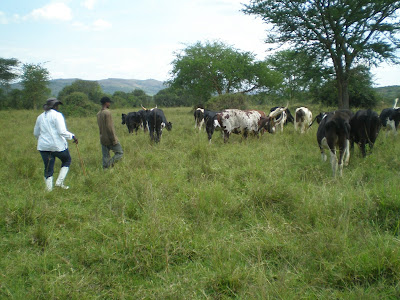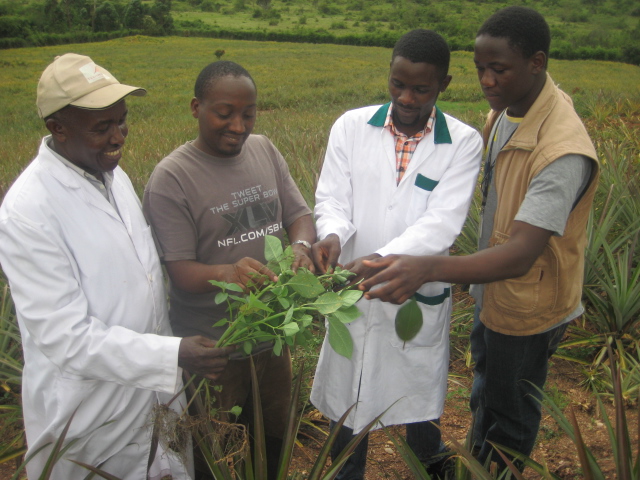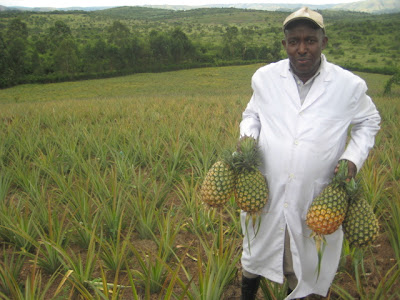A raised Granny structure.
The Post Harvest Style.
According
to the report from Uganda coffee development Authority, Coffee
quality is affected by the method of harvesting , drying and storage
process(post harvest process).
Fresh
produce cannot replace carbohydrates or water after harvest. Respiration uses
stored starch or sugar and will stop when reserves of these are exhausted;
ageing follows and the produce dies and decays.
Effect
of air supply on respiration. Respiration depends on a good air supply. Air
contains about 20 percent of the oxygen essential to normal plant respiration,
during which starch and sugars are converted to carbon dioxide and water
vapour. When the air supply is restricted and the amount of available oxygen in
the environment falls to about 2 percent or less, fermentation instead of
respiration occurs. Fermentation breaks down sugars to alcohol and carbon
dioxide, and the alcohol produced causes unpleasant flavours in produce and
promotes premature ageing.
The
effect of carbon dioxide on respiration. Poor ventilation of produce because of
restricted air supply leads also to the accumulation of carbon dioxide around
the produce. When the concentration of this gas rises to between I and 5
percent in the atmosphere, it will quickly ruin produce by causing bad
flavours, internal breakdown, failure of fruit to ripen and other abnormal
physiological conditions. Thus, the proper ventilation of produce is essential.
Transpiration, or the loss of water
Most fresh
produce contains from 65 to 95 percent water when harvested. Within growing
plants there is a constant flow of water. Liquid water is absorbed from the
soil by the roots, then passed up through the stems and finally is lost from
the aerial parts, especially leaves, as water vapour.
Photosynthesis and respiration
The passage
of water through the plants is called the transpiration stream. It maintains
the high water content of the plant, and the pressure inside the plant helps to
support it. A lack of water will cause plants to wilt and perhaps to die.
The surfaces
of all plant parts are covered by a waxy or corky layer of skin or bark
limiting water loss. Natural water loss from the plant occurs only through tiny
pores, which are most numerous on the leaves. The pores on the plant surfaces
can open or close with changing atmospheric conditions to give a controlled
rate of loss of water and to keep the growing parts in a firm condition.
Fresh
produce continues to lose water after harvest, but unlike the growing plant it
can no longer replace lost water from the soil and so must use up its water
content remaining at harvest. This loss of water from fresh produce after
harvest is a serious problem, causing shrinkage and loss of weight.
When the
harvested produce loses 5 or 10 percent of its fresh weight, it begins to wilt
and soon becomes unusable. To extend the usable life of produce, its rate of
water loss must be as low as possible.
The
effect of moisture content of the air on water loss. Air spaces are present
inside all plants so that water and gases can pass in and out to all their
parts. The air in these spaces contains water vapour, a combination of water
from the transpiration stream and that produced by respiration. Water vapour
inside the plant develops pressure causing it to pass out through the pores of
the plant surface. The rate at which water is lost from plant parts depends on
the difference between the water vapour pressure inside the plant and the
pressure of water vapour in the air. To keep water loss from fresh produce as
low as possible, it must be kept in a moist atmosphere.
The
effect of air movement on water loss. The faster the surrounding air moves over
fresh produce the quicker water is lost. Air movement through produce is
essential to remove the heat of respiration, but the rate of movement must be
kept as low as possible. Well-designed packaging materials and suitable
stacking patterns for crates and boxes can contribute to controlled air flow
through produce.
The
Influence of the type of produce on water loss. The rate at which water is lost
varies with the type of produce. Leafy green vegetables, especially spinach,
lose water quickly because they have a thin waxy skin with many pores. Others,
such as potatoes, which have a thick corky skin with few pores, have a much
lower rate of water loss.
The
significant factor in water loss is the ratio of the surface area of the type
of plant part to its volume. The greater the surface area in relation to the
volume the more rapid will be the loss of water.
Ripening
of fruits
Fleshy
fruits undergo a natural stage of development known as ripening. This occurs
when the fruit has ceased growing and is said to be mature. Ripeness is
followed by ageing (often called senescence) and breakdown of the fruit. The
fruit referred to here includes those used as vegetables or salads, such as
aubergine, sweet pepper, tomato, breadfruit and avocado.
There are
two characteristic types of fruit ripening that show different patterns of
respiration:
Non-climacteric fruit ripening-refers to
those fruits which ripen only while still attached to the parent plant. Their
eating quality suffers if they are harvested before they are fully ripe because
their sugar and acid content does not increase further. Respiration rate slows
gradually during growth and after harvest. Maturation and ripening are a
gradual process. Examples are: cherry, cucumber, grape, lemon, pineapple.
Climacteric fruit ripening-refers to fruits
that can be harvested when mature but before ripening has begun. These fruits
may be ripened naturally or artificially. The start of ripening is accompanied
by a rapid rise in respiration rate, called the respiratory climacteric. After
the climacteric, the respiration slows down as the fruit ripens and develops
good eating quality. Examples are: apple, banana, melon, papaya, tomato.
In
commercial fruit production and marketing, artificial ripening is used to
control the rate of ripening, thus enabling transport and distribution to be
carefully planned.
The
effect of ethylene on post-harvest fresh produce. Ethylene gas is produced in
most plant tissues and is known to be an important factor in starting off the
ripening of fruits. Ethylene is important in fresh produce marketing because:
it can be used commercially for the
artificial ripening of the climacteric fruits. This has made it possible for
tropical fruits such as mangoes and bananas to be harvested green and shipped
to distant markets, where they are ripened under controlled conditions;
natural ethylene production by fruits can
cause problems in storage facilities. Flowers, in particular, are easily
damaged by very small amounts of the gas. Ethylene destroys the green colour of
plants, so lettuce and other vegetables marketed in the mature green but unripe
state will be damaged if put into storage with ripening fruit;
ethylene production is increased when
fruits are injured or attacked by moulds causing decay. This can start the
ripening process and result in early ripening of climacteric fruit during
transport. All produce should be handled with care to avoid injuries leading to
decay. Damaged or decaying produce should not be stored;
citrus fruit grown in tropical areas
remains green after becoming fully ripe on the tree. It develops full colour
after harvest only if "degreened" by the use of (manufactured) ethylene
gas. The gas concentration, temperature, humidity and ventilation have to be
carefully controlled in specialized rooms, so degreening is economically viable
only for high-value export or domestic markets. In most tropical countries
fully ripe green citrus fruit is acceptable to local populations.
4.10
Post-harvest damage to fresh produce
Physical
damage to fresh produce can come from a variety of causes, the most common
being:
Mechanical injury. The high moisture content and soft texture of fruit,
vegetables and root crops make them susceptible to mechanical injury, which can
occur at any stage from production to retail marketing because of:
poor harvesting practices;
unsuitable field or marketing containers
and crates, which may have splintered wood, sharp edges, poor nailing or
stapling;
overpacking or underpacking of field or
marketing containers;
careless handling, such as dropping or
throwing or walking on produce and packed containers during the process of
grading, transport or marketing.
Injuries
caused can take many forms:
splitting of fruits or roots and tubers
from the impact when they are dropped;
internal bruising, not visible externally,
caused by impact;
superficial grazing or scratches affecting
the skins and outer layer of cells;
crushing of leafy vegetables and other soft
produce.
Injuries
cutting through or scraping away the outer skin of produce will:
provide entry points for moulds and
bacteria causing decay;
increase water loss from the damaged area;
cause an increase in respiration rate and
thus heat production.
Bruising
injuries, which leave the skin intact and may not be visible externally cause:
increased respiration rate and heat
production;
internal discoloration because of damaged
tissues;
off-flavours because of abnormal
physiological reactions in damaged parts.
Injuries from temperature effects. All fresh produce is subject to damage when
exposed to extremes of temperature. Commodities vary considerably in their
temperature tolerance. Their levels of tolerance to low temperatures are of
great importance where cool storage is concerned:
Freezing injury-all produce is subject to
freezing at temperatures between 0 and -2 degrees Celsius. Frozen produce has a
water-soaked or glassy appearance. Although a few commodities are tolerant of
slight freezing, it is advisable to avoid such temperatures because subsequent
storage life is short. Produce which has recovered from freezing is highly
susceptible to decay.
Chilling injury- some types of fresh
produce are susceptible to injury at low but non-freezing temperatures. Such
crops are mostly of tropical or subtropical origin, but a few temperate crops
may be affected
Effect of
chilling injury Symptom
Discoloration
Internal or external or both, usually
brown or black
Skin piking Sunken spots, especially under dry conditions
Abnormal
ripening (fruits) Ripening is uneven or
fails; off-flavours
Increase in
decay Activity of micro-organisms
Susceptibillty of fruits and vegetables to chilling injury at low but
non-freezing temperatures
Commodity Approximate lowest safe temperature °C Chilling injury symtoms
Aubergines 7 Surface
scald, Alternaria rot
Avocados 5-13 Grey
discoloration of flesh
Bananas
(green/ripe) 12-14 Dull, gray-brown skin color
Beans
(green) 7 Pitting, russeting
Cucumbers 7 Pitting
water-soaked spots, decay
Grapefruit 10 Brown
scald, piking, watery breakdown
Lemons 13-15 Pitting,
membrane stain, red blotch
Limes 7-10 Pitting
Mangoes 10-13 Grey
skin scald, uneven ripening
Melons:
Honeydew 7-10 Pitting failure to ripen, decay
Watermelon 5 Pitting,
biker flavour
Okra 7 Discoloration,
water-soaked areas, piking
Oranges 7 Pitting
brown stain, watery breakdown
Papaya 7 Pitting
failure to ripen, off-flavour, decay
Pineapples 7-10 Dull
green colour, poor flavour
Potatoes 4 Internal
discoloration, sweetening
Pumpkins 10 Decay
Sweet
peppers 7 Pitting Alternaria rot
Sweet potato
13 Internal
discoloration, piking, decay
Tomatoes:
Mature green 13 Water-soaked softening, decay
Ripe 7-10 Poor
colour, abnormal ripening, Alternaria rot
Source Lutz,
J.M. and Hardenburg, R.E., 1966, The commercial storage of fruits, vegetables
and florist And nursery storks, Agricultural Handbook No. 66, USDA, Washington
Sensitivity
varies with the commodity, but with each there is a temperature below which
injury occurs: the lowest safe temperature (LST). Within a single commodity
type, the LST may vary between varieties . Fruit is generally less
sensitive when ripe.
Symptoms of
chilling injury may not develop until the produce is removed from cold storage
to normal market (i.e. ambient) temperatures. When susceptible produce has to
be held for some time in storage, it must be kept at a temperature just above
its LST. This means that such crops will have a shorter marketing life than
non-sensitive crops because respiration has continued at a relatively fast rate
during storage at higher than normal cold-storage temperatures.
High temperature injury - if fresh produce
is exposed to high temperatures caused by solar radiation, it will deteriorate
rapidly. Produce left in the sun after harvest may reach temperatures as high
as 50 degrees Celsius. It will achieve a high rate of respiration and, if
packed and transported without cooling or adequate ventilation, will become
unusable. Long exposure to tropical sun will cause severe water loss from
thin-skinned root crops such as carrots and turnips and from leafy vegetables.
Diseases and pests. Diseases caused by fungi and bacteria commonly result in
losses of fresh produce. Virus diseases, which can cause severe losses in
growing crops, are not a serious post-harvest problem.
Insect pests
that are mainly responsible for wastage in cereals and grain legumes are rarely
a cause of post-harvest loss in fresh produce. Where they do appear, they are
often locally serious, e.g. the potato tuber moth.
Diseases.
Losses from post-harvest disease in fresh produce fall into two main
categories.
Loss in
quantity, the more serious, occurs where deep penetration of decay makes the
infected produce unusable. This is often the result of infection of the produce
in the field before harvest.
Loss in
quality occurs when the disease affects only the surface of produce. It may
cause skin blemishes that can lower the value of a commercial crop. In crops
grown for local consumption, the result is less serious since the affected skin
can often be removed and the undamaged interior can be used.
Fungal and
bacterial diseases are spread for the most part by microscopic spores, which
are widely distributed in the air and soil and on dead and decaying plant
material. Produce can become infected:
through injuries caused by careless
handling, by insect or other animal damage, or through growth cracks
through natural pores in the above- and
below-ground parts of plants, which allow the movement of air, carbon dioxide
and water vapour into and out of the plant;
by direct penetration of the intact skin of
the plant (see colour section, Figure 2). The time of infection varies with the
crop and with different diseases. It can occur in the field before harvest or
at any time afterwards.
Field
infections before harvest may not become visible until after harvest. For
example, decay of root crops caused by soil moulds will develop during storage.
Similarly, tropical fruits infected at any time during their development may
show decay only during ripening.
Infection
after harvest can occur at any time between the field and the final consumer.
It is for the most part the result of invasion of harvesting or handling
injuries by moulds or bacteria.
Post-harvest
diseases may be spread in the field before harvest by the use of infected seed
or other planting material. Many diseases can survive by using weed plants or
other crops as alternate or alternative hosts. They are also spread by means of
infected soil carried on farm implements, vehicles, boots, etc. and from crop
residues or rejected produce left decaying in the field.
Post-harvest
diseases can also be spread by:
field boxes contaminated by soil or
decaying produce or both;
contaminated water used to wash produce
before packing;
decaying rejected produce left lying around packing houses;
contaminating healthy produce in packages.
Pests.
Although relatively few post-harvest losses of fresh produce are caused by
attacks of insects or other animals, localized attacks by these pests may be
serious.
Insect damage is usually caused by insect
larvae burrowing through produce, e.g. fruit fly, sweet potato weevil, potato
tuber moth. Infestation usually occurs before harvest. Post-harvest spread is a
problem where produce is held in store or is exposed to lengthy periods of
transport.
Rats, mice and other animal pests again are
sometimes a problem when produce is stored on the farm.
Loss
assessment
There are no
generally accepted methods for evaluating post-harvest losses of fresh produce.
Whatever evaluation method may be used, the result can refer only to the
described situation.
In the
appraisal of an existing marketing operation, the accurate evaluation of losses
occurring is a problem. It may be suspected that losses are too great, but
there may be no figures to support this view because:
records do not exist;
records if available do not cover a long
enough period of time;
the figures available are only estimates
made by several observers;
records may not truly represent a
continuing situation; for example, losses may have been calculated only when unusually
high or low;
loss figures may be deliberately over- or
understated for commercial or other reasons in order to gain benefits or to
avoid embarrassment.
Consequently,
if accurate records of losses at various stages of the marketing operation have
not been kept over a period of time, a reliable assessment of the potential
cost-effectiveness of ways to improve handling methods is virtually impossible,
and the marketing position of the grower is difficult to strengthen. It is
evident that the grower who wants to reduce his post-harvest losses must
maintain reliable records.
| 



.jpg)
.jpg)














.jpg)
 Agriculture in Africa is considered to be the backborn of the economy however a big percentage of farmers is still in the narrow income group. talking to the farmers in the photos, Lack of post-harvests handling skills is the key problem. This is because African soils are fertile and with high crop yielding
Agriculture in Africa is considered to be the backborn of the economy however a big percentage of farmers is still in the narrow income group. talking to the farmers in the photos, Lack of post-harvests handling skills is the key problem. This is because African soils are fertile and with high crop yielding 










